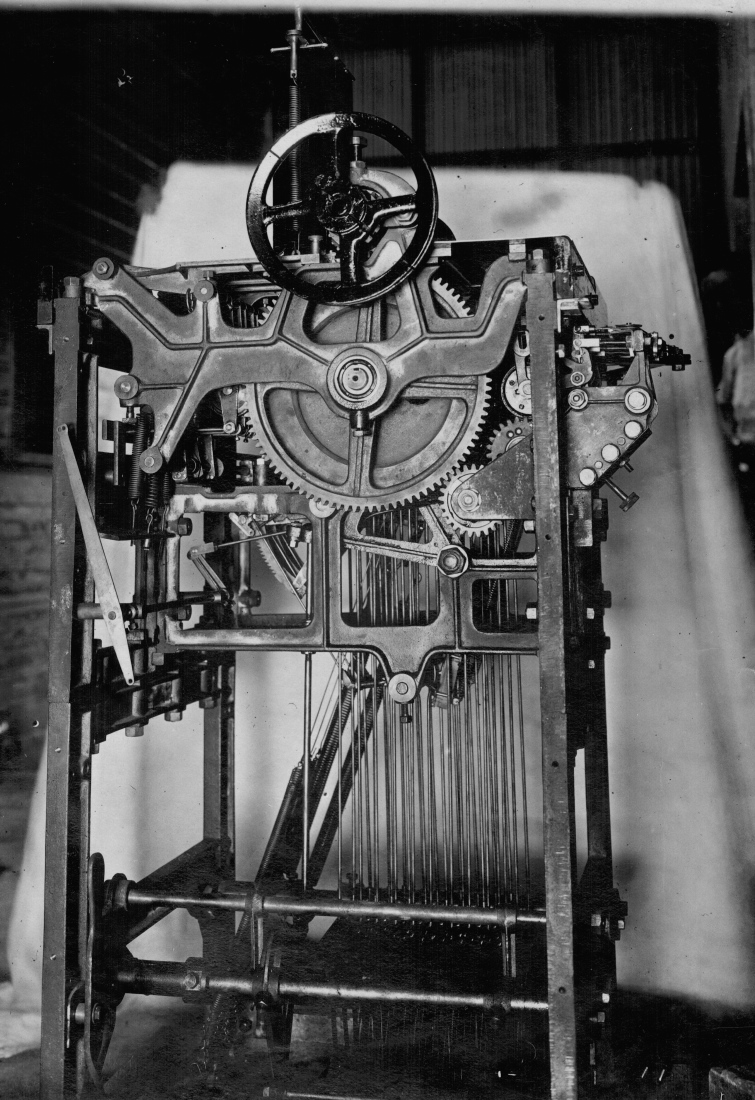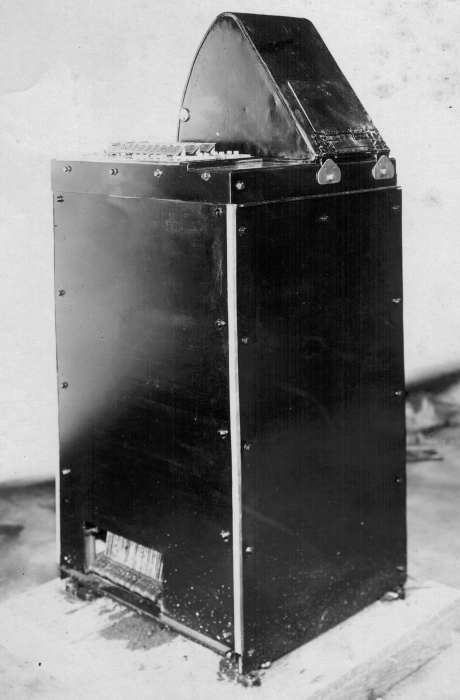This technology history page contains a photograph, which is one of several belonging to the Photo Gallery pages, which are part of several pages relating to the invention of the world's first automatic totalizator in 1913 and Automatic Totalisators Limited, the Australian company founded in 1917 by George Julius, to develop manufacture and export these systems.
Copyright © 1998 Email - totehis@hotmail.com
J1 TIM for Most Modern Machine In Australia 1916
This is a J1 Ticket Issuing Machine (TIM) with its covers removed. Multiple terminals like this one were part of a Julius Totalisator which has been referred to as the most modern machine in Australia by The West Australian newspaper. An extract from this article is presented below. The J1 was developed for the West Australian Trotting Association and these terminals were installed at Gloucester Park in Perth. They were used by tellers to sell totalizator tickets, which were accumulated on a central mainframe, all part of a Julius Totalizator system. George Julius named his totalizator product The Premier Totalisator. These J1s were part of an on line, real time, multi user system, long before the electronic systems that made these concepts commonplace. This makes the J1 the first multi user computing system terminal. As can be seen, it is purely mechanical. The Julius Totes became electromechanical in 1917, the same year Automatic Totalisators Limited was founded. The prime reason for the move to electromechanical systems was to provide for larger systems and more distributed points of sale.
More after the image...

Click on the image to go back to the Photo Gallery
If you arrived from navigating the website, use the navigation bar at the bottom of this page.
This photograph is over a century old and was 100 years old in 2016--Terminals for a real time multi user computing system over a century ago!
The top of the J1 has buttons to operate it, which are out of view in the image above but can be seen in the image below. A sheet has been held up behind the J1 in the image above to highlight the workings of the terminal and keep it from blending in with the background. Corrugated iron walls can be seen above the sheet indicating that it is probable this photograph was taken in the Alice Street Newtown factory.
This TIM was patented in Australia in 1914, a year after the World's First Automatic Totalisator commenced operation in Ellerslie Auckland New Zealand, which was invented by George Julius. It would be another three years until George Julius founds Automatic Totalisators Limited. At that time, George already had an engineering consulting company, which would become Julius Poole and Gibson. This engineering consulting company, at the end of the 20th century, was Australia's oldest engineering consulting company. The forerunner to Automatic Totalisators Limited was an Australian company called Totalling Mechanisms Limited, which was formed in 1911 and produced the Ellerslie system as well as the Gloucester Park system. The Gloucester Park totalisator was the second of the Julius Totes. You might ask, if the J1 was patented in 1914 what did the first Julius tote, which commenced operation in 1913, use instead of these terminals? In the Ellerslie system the selling stations were more like an integral part of the totalisator mainframe and they were housed in what were referred to as selling booths, which were in close proximity to the mainframe all in the one tote house.
The name J1 is a ticket issuing machine type identification, with the J indicating it belongs to a Julius Tote with the following digits indicating the model number. This TIM type numbering however, outlived the Julius Totes and was continued after the transition to computer based totalisator design and manufacture, after George passed away in 1946. The J22 for instance is the company's first microprocessor based TIM, used with digital computer based totalisators the company developed. The J22 is a terminal I had a lot to do with and marks the point where I came into this industry in 1977. In 2018 I still have in my posession a J22 in my collection of mementos. This terminal has three pages related to it in the Photo Gallery chapters of this website. To learn more about the J22, click on the image above, then scroll down in the Photo Gallery index to the thumbnail with the associated text starting with Part of the J22 production line..., select this thumbnail or any of the three following thumbnails which all relate to the J22 terminal. The second of these four thumbnails features the J22 in my collection.
Sir George Julius made a comment in a 1932 article, which appeared in the Gippsland Times Newspaper relating to the J1 TIM. The content of this article is made available by the National Library of Australia on its Trove website with the following details:
1932 'HOW THE AUTOMATIC TOTALISATOR WAS INVENTED', Gippsland Times (Vic. : 1861 - 1954), 7 January, p. 3. , viewed 20 May 2016, http://nla.gov.au/nla.news-article62691937
Following is George's comment relating to the J1 TIM, extracted from the Gippsland Times article:
Somewhat earlier--in 1916---I had come to the conclusion that success would be facilitated if the machine could print the tickets as they were sold, and that the act of printing should give the impetus to the recording mechanism. I then produced a ticket-issuing machine, which printed the number of a horse and other information, but the connection with the recording mechanism was by means of a complicated series of steel wires.
The steel wires can be seen running vertically inside the frame of the J1 in the image above. Sir George also made an observation about Australian workmen, in this Gippsland Times newspaper article. Sir George's concluding statement in the article is:
These machines have all been built in Australia in almost every detail, and are a tribute to the abilities of the Australian workman.
The complete transcript of the Gippsland Times article titled How the Automatic Totalisator was Invented appears on this website in the Mechanical Aids to Calculation chapter. To view this select the Go to the index button in the navigation bar at the bottom of this page and select the Mechanical Aids to Calculation chapter in the Firstly section.
J1 TIM with access covers closed 
The image above shows the J1 with its side panels attached and its hinged access covers closed. The next page, accessible via the Next page button in the navigation bar at the bottom of this page, shows a top view of the J1 with its access doors open. Taking into account that this photograph is over a century old, it is still odd that this machine looks like it has endured some heavy service. The top arched cover is clearly dented. All the other company product photographs I have seen have been of new equipment.
This arched cover mentioned protects the ticket store, consisting of three ticket stacks, along with three ticket transport wheels, one for each stack and associated mechanics. The three ticket stacks can be seen in the image at the top of this page, extending above the flat top of the J1 behind the drive pulley. Access to this section of the machine seems to be limited to specialist staff, as a keyhole is visible down low on the far left side of the arched cover, indicating it can be locked shut. The keyboard mechanism is visible secured flat on the top of the TIM at the base of the arched cover. The tickets are ejected from a slot which is out of view, at the opposite side of the arched cover, around the corner from the keyhole and at the base of the arc section where it meets the top surface of the TIM which the keyboard is lying on.
At the left near side of the J1 TIM in the image above, the operator side with the keyboard, there is a cutaway section in the side plate near foot level, which appears to reveal 30 rods with near horizontal bends protruding at the bottom end. As there are 30 runner buttons on the keyboard, visible in the image in the next page, I will hazard a guess that this is a means of locking out scratched runners and runner numbers greater than the field size, from being accidentally selected. As we are looking at the base of the J1 it seems to be sitting on, and well secured to, a thick wooden plynth. This suggests that it is not in a location where it has been in use, or will be used, but has probably been recently transported or is ready for transportation.
Thanks to Prof. Bob Doran for sending me an electronic text version of an article in The West Australian newspaper dated Thursday 13 May 1915 titled THE TOTALISATOR with subtitle Most Modern Machine in Australia. The following extract from this article, describes the new Julius Totalisator system for Gloucester Park and refers to the J1 as special ticket issuers:
There is, however, one improvement which the local machine has upon the Auckland tote, namely, that here the machine is fitted with special ticket issuers. The totalisator on the association's grounds is what is known as a "28 horse six clerk machine." It is capable of selling up to 500 tickets per minute, or at the rate of 80 tickets odd per clerk during the space of 60 seconds. Under the present hand-selling system, the quickest clerk will not sell more then 25 tickets per minute, and given the best possible conditions, six such clerks could not dispose of more than 1500(sic) tickets during the time.
Webmaster's note: I think the 1500 in the previous sentence should read 150. If the quickest clerk can produce 25 tickets then 6 such clerks will produce 150.
A larger extract from this article in The West Australian newspaper can be read by selecting the Previous page button at the bottom of this page and scrolling down to the subtitle Most Modern Machine in Australia.

Comments and suggestions welcome to
totehis@hotmail.com 


